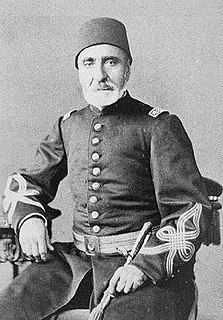 W
WThe 16 Great Turkic Empires is a concept in Turkish ethnic nationalism, introduced in 1969 by Akib Özbek, map officer and widely invoked by Turkish authorities during the 1980s, under the government of Kenan Evren. Prior to this assertion, the 16 stars had been taken as representing sixteen medieval beyliks which succeeded the Seljuk Empire.
 W
WTurkey has no official national emblem, but the crescent and star design from the national flag is in use as the de facto national emblem on Turkish passports, Turkish identity cards and at the diplomatic missions of Turkey.
 W
WEvery sultan of the Ottoman Empire had his own monogram, called the tughra, which served as a royal symbol. A coat of arms in the European heraldic sense was created in the late 19th century. Hampton Court requested from the Ottoman Empire a coat of arms to be included in their collection. As the coat of arms had not been previously used in the Ottoman Empire, it was designed after this request, and the final design was adopted by Sultan Abdul Hamid II on 17 April 1882.
 W
WTurkey has no official national emblem, but the crescent and star design from the national flag is in use as the de facto national emblem on Turkish passports, Turkish identity cards and at the diplomatic missions of Turkey.
 W
WThe flag of Turkey, officially the Turkish flag, is a red flag featuring a white star and crescent. The flag is often called al bayrak, and is referred to as al sancak in the Turkish national anthem. The current design of the Turkish flag is directly derived from the late Ottoman flag, which had been adopted in the late 18th century and acquired its final form in 1844. The measures, geometric proportions, and exact tone of red of the flag of Turkey were legally standardized with the Turkish Flag Law on 29 May 1936.
 W
WGrey wolf is a sacred animal and national symbol in Turkic and Mongol mythology.
 W
WThe Ottoman Empire used anthems since its foundation in the late 13th century, but did not use a specific imperial or national anthem until the 19th century. During the reign of Mahmud II, when the military and imperial band were re-organized along Western lines, Giuseppe Donizetti was invited to head the process. Donizetti Pasha, as he was known in the Ottoman Empire, composed the first Western-style imperial anthem, the Mahmudiye Marşı.
 W
W"İstiklâl Marşı" is the national anthem of both Turkey and Northern Cyprus. It was officially adopted by Grand National Assembly on 12 March 1921—two-and-a-half years before the 29 October 1923 establishment of the nation—both as a motivational musical saga for the troops fighting in the Turkish War of Independence, and as an aspirational anthem for a Republic that was yet to be established.
 W
WThe Presidential Seal of Turkey is the official seal of the President of Turkey. It has a large 16-pointed Sun which symbolizes the Republic of Turkey in the center, which is surrounded by 16 five-pointed stars, symbolizing the 16 Great Turkic Empires in history. It is the oldest presidential seal in the world still in use.
 W
WThe star and crescent is an iconographic symbol used in various historical contexts, including as a prominent symbol of the Ottoman Empire, with numerous modern countries still using it as a national symbol. It was developed in the Greek colony of Byzantium ca. 300 BCE, though it became more widely used as the royal emblem of Pontic king Mithradates VI Eupator after he incorporated Byzantium into his kingdom for a short period. During the 5th century, it was present in coins minted by the Persian Sassanian Empire; the symbol was represented in the coins minted across the empire throughout the Middle East for more than 400 years from the 3rd century until the fall of the Sassanians after the Muslim conquest of Persia in the 7th century. The conquering Muslim rulers kept the symbol in their coinage during the early years of the caliphate, as the coins were exact replicas of the Sassanian coins.
 W
WThe griffon vulture is a large Old World vulture in the bird of prey family Accipitridae. It is also known as the Eurasian griffon. It is not to be confused with a different species, Rüppell's griffon vulture. It is closely related to the white-backed vulture.